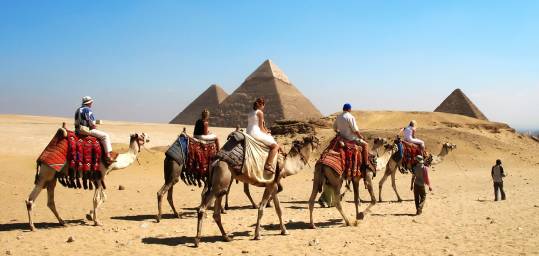A group of deaf tourists from Germany might not have been able to hear about the wonders of Egypt, but with a little indulgence, a tour guide helped them out.
During the day, tour guide Ziad Anwar faced the sun. In closed areas and at night, he lit his mouth with a torch.
The tourists asked him to shave off his moustache. They would then be able to read his lips with ease. He did.
This was Anwar’s first such experience. “Dealing with any handicapped tourist is difficult,” he says. “It requires a lot of preparation and a special way of dealing.”
Twenty-five deaf German tourists spent two weeks travelling through Cairo, Giza, Luxor, Aswan and Sinai and Ziad Anwar was their guide. Organized by a German association for the deaf, the group was made up of people who had once been able to hear.
Knowing that he wouldn’t be easily understood, Anwar printed a booklet describing the monuments and places they would visit, and distributed it on the first day of their trip. “I also had to talk slowly in German, clearly and in simple language,” he says.
But he wasn’t on his own. The group’s tour leader from Germany assisted Anwar in his task, translating his words into sign language, and some of the tourists wore hearing aids.
In the mornings, Anwar and the tour leader would go door-to-door, with the help of master keys, “because they could not hear the wake-up call,” he says.
Crowds also presented a problem. Once, some of the tourists got dispersed; “They couldn’t hear me so I ran after them and tapped them on their shoulders,” he recalls, and he directed them to the rest of the group.
During the group’s climb up Mount Sinai, Anwar hired someone to walk at the front while he remained behind, making sure the group stuck together.
These are among the preparations made by Anwar who had once before hosted a group of blind tourists. They, in turn, had taught him about the importance of using vivid, detailed, verbal descriptions of each site. “Patience is the keyword when dealing with handicapped people,” he stresses.
Anwar was not entirely savvy with the group of deaf tourists, however, and had some myths of his own to break. On the group’s Luxor-Aswan cruise, he thought they wouldn’t enjoy the galabiya party because they wouldn’t be able to hear the music. But they danced from the beginning to end, moving to the vibrations their bodies felt as loudspeakers blared the music.
And then there were some misunderstandings that were just laughed off: When the group stood at the gates of Medinet Habu on the west bank of the Nile in Luxor, Anwar said the word “Habu.” Someone responded, “Oh, we’ll have some,” referring rather to “hamburgers.”
But he does feel that he’s developed a certain knack with tourists who require a different type of tour and has noticed some surprising differences. On the normal tour, he says, the bus is always quiet and the guide does the talking. In the case of the deaf group, he says, “The guide doesn’t talk at all and the tourists chat with one another (by moving their lips and uttering sounds in the process). They speak in very loud voices and the bus starts to resemble a marketplace.”
Tourism for the disabled is not yet developed in Egypt but Anwar feels that it has a great potential. He suggests that specially trained tour guides, documentary films, photos, video tapes and other aides be made available to tour guides like himself.
Now, if there are any disabled people in groups, he feels “an affinity towards them” and tries to make their trip even more enjoyable than might be expected.

